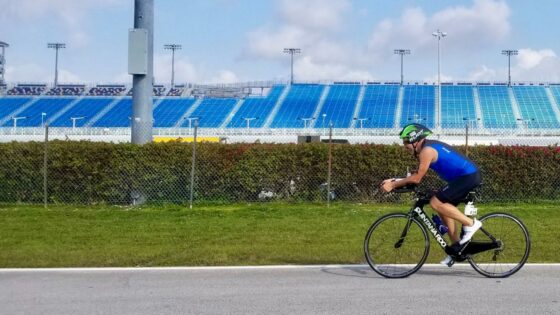
With Louisville just around corner, athletes competing in the event are eager to learn more about the course and how to approach race day given the unique characteristics of the event: a time trial swim start, moderately hilly bike course, and the potential for a very hot race day.
Here are some additional resources for you:
- Louisville 2010: Quick Recap
- Louisville 2010 Race Report Podcast Series
- Louisville 2010 Report Part Two: Results and Testimonials
Ironman® Louisville: Coach Advice for the Event
What is the swim like?
The Louisville swim is probably the most unique swim on the IM calendar. Louisville is a time trial, non-wetsuit start while every other US Ironman® is a wave start. The start order is “first come, first served,” and the countdown for the swim cutoff begins when the LAST person gets in the water. This is how it works out on race day:
- Get your transition set up and then you’ll walk about half mile upriver to a small park/dock to get in line. Your position in line is your position in the line, and the earlier you get in line, the closer you are to the front, the closer to 7am you get in the water and the more time (see swim cutoff note above) you have to complete the swim.
- At 7am the first age-grouper gets in the water and the organizers do their best to start the next and the next and the next in 1-2 second intervals. You can do the math, but in ’07 it took them about 37 minutes to get everyone in the water. In ’08 it took 45 minutes. If you are in danger of not making the swim cutoff, it behooves you to get in line very, very early.
- You will swim upriver, but between an island and the mainland, so there is very little to no current. You’ll swim past the end of the island a few hundred meters, make a left and a left again into the current, then swim downriver to the swim exit and transition area. It’s funky, but if you look at the historical swim times from the event you’ll see that they look to be on par with every other Ironman® swim. More importantly, everyone has to do it so it’s not a big deal.
What is transition like?
Very simple. You’ll run up a boat ramp, through the changing tents and out to your bike on the grass. You’ll enter the bike course on a wide sidewalk or directly onto the road. The transition is simple and straight forward.
What is the bike course like?
The Louisville bike course is “fair,” in that you’re not struggling to survive against a wicked hilly course stacked with long climbs, longer descents, mind-numbing flats or other variables. It’s just…a bike ride with some flats, some hills (but nothing crazy) and some downhills (but nothing scary). It has a little bit of everything: bottle-tossing train tracks (early), flat along the river, rolling hills in the horse country, tons of spectators through Lagrange, flat to generally downhill and fast back to transition.
You start flat along the river to a short climb into Prospect. Once through Prospect the course is rolling to the start of the out and back. In the center of the out and back is a creek/low ground so it’s generally downhill, across the creek, uphill, flat, flip it and return. The bridge across the creek is at the very bottom of the hill = a good bit of speed, and of course it has a rough seam on the right side that is known to launch bottles and other gear. Hit the bridge towards the center and you’ll be fine.
Once you’ve completed the out and back, you turn right and carry on to the start of a counterclockwise loop that you do twice. The loop has a little bit of everything but nothing too crazy or anything to be overly concerned about. At the end of the second loop you continue straight, generally downhill and flat back to Louisville WITHOUT doing the out and back. Yep, you only do it once, on your way out to the loop. That’s it, pretty straight forward. If you are looking for some extra credit information, please read our Climbing Smart on Race Day article. It’s helped thousands of triathletes have great races on hilly courses.
What is the run like?
It’s more or less a dead flat out and back, with just enough slight turns that you don’t see miles and miles into the distance. The only “hills” are a climb just past the top of a bridge over the Ohio and almost into Indiana, before flipping it and coming back (you only do this Ohio bridge thing once, at the start of the first lap); and a dive under an overhead train bridge. As you head back towards the end of the first lap, you’ll take a quick jog left, then right, running maddeningly close to the finishing chute…before flipping a u-turn and heading back out for Lap Two.
The toughest part has to be that it’s six miles straight out of town, minimal turns, which puts you very, very far away from spectators and free mojo. There are many, quiet miles to be had out there…very tough!
What Can My Family do on Race Day?
If they want to see you on the bike, the town of Lagrange puts on a neat family festival they can attend while they wait for you to come through town twice on the loop (your kids can play with a fire truck!). If they want to stay in Louisville while you ride, downtown Louisville, and especially Fourth Street Live, offer a range of activities. In fact, if you look at the course maps, you’ll see that a good portion of the area along the river between the finish and transition area is grass, a large park, a playground and other options for staying busy. Just make sure the family is prepared for a long day in the heat (see below).
I’ve heard the finish line is very unique?
Yep! Picture your typical urban downtown with high rises on either side of the street. Now put a class ceiling, about 3 stories up, over about 2-3 blocks of the main street. Fill this covered area with bars and restaurants, a cross walk overhead to a food court…and now put the finish of an Ironman® right there in the middle of it all! Very cool, very unique…very LOUD.
What’s the Biggest Mistake I Could Make?
Without a doubt, overcooking the bike, especially on the hills. We highly recommend that you commit yourself to Just Riding Along (JRA) for the first 90 to 120 minutes, ignoring the others around you. Last year Coach Patrick was spectating on the bike out and back, and people were already over-extending themselves!!
The most important thing you need to do is to stay on top of your hydration, making sure you take in enough fluid through the heat and all of the terrain changes. The second more important thing to do is to stay as cool as possible on the bike — this means dumping water on the back of your neck and, if need be, on your shorts (femoral artery).
Also, the last 20 miles of the bike course are pretty fast and you want to be able to take advantage of that by not being That Guy. You know, the one who is too shelled from having drilled himself for 90 miles and is now relegated to the hoods with 20 miles to think about how in the world can he possibly run a marathon in this heat with these legs. In other words, it pays to be smart so you can finish fast and confidently vs slowly and terrified of the run.
What is the Temperature Like on Race Day?
Bad news? It’s gonna be hot. Hot and humid. Good news? You KNOW it’s going to be hot and humid…it’s Kentucky in August! (2009 was an outlier with the cooler temps.) Trust us, that piece of mind vs the unknown of other races (such as Coeur d’Alene, IMUSA, or IMWI) is actually very valuable. Pretty much everyone in the US should have plenty of time to train in the heat before the event so the heat is usually not the problem that it sometimes is at other, less weather-consistent races.
What’s Your Top Swim Tip?
Only go as fast as your ability to maintain good form. If your form begins to go because you are tired or working too hard, just slow down. It’s a long day, so don’t sweat 2-3 minutes on the swim. Don’t try to get all Ricky Racer with drafting and current strategery — swim your swim and you’ll be fine!
What’s Your Top Bike Tip?
You’re basically warming up until about mile 40 of the bike (don’t worry, the hammerheads will come back to you or you’ll see them on the run). After that, ride steady and stay on top of your nutrition.
What’s Your Top Run Tip?
Run very easy for the first 6 miles, then settle into your pace, preparing for the real race that starts at mile 18. At mile 18, put your head down and get it done. Count the number of people you’re passing and keep your head in the game. You can do anything for 8 miles!
Additional Resources
FREE Race Seminars
Visit our FREE Resources page to find an extensive library of training and racing guidance. Tap into our years of experience to take your triathlon game to the next level!
Four Keys Pre-Race Talk
Coach Patrick will be on hand to support TeamEN, our ENFans, and deliver our Four Keys Pre-Race talk to the general public. All attendees will receive a FREE Four Keys DVD! Go here for more details and to RSVP to the talk




Leave a Reply